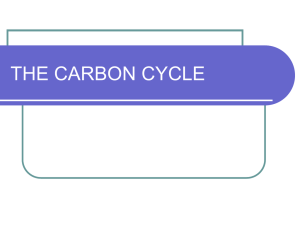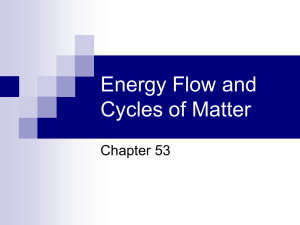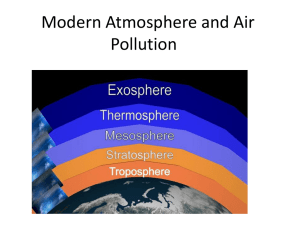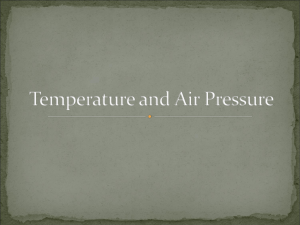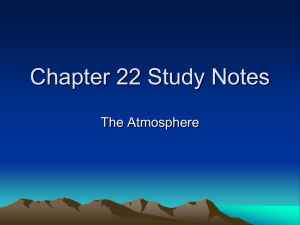Atmospheres of the Planets and their Moons
advertisement
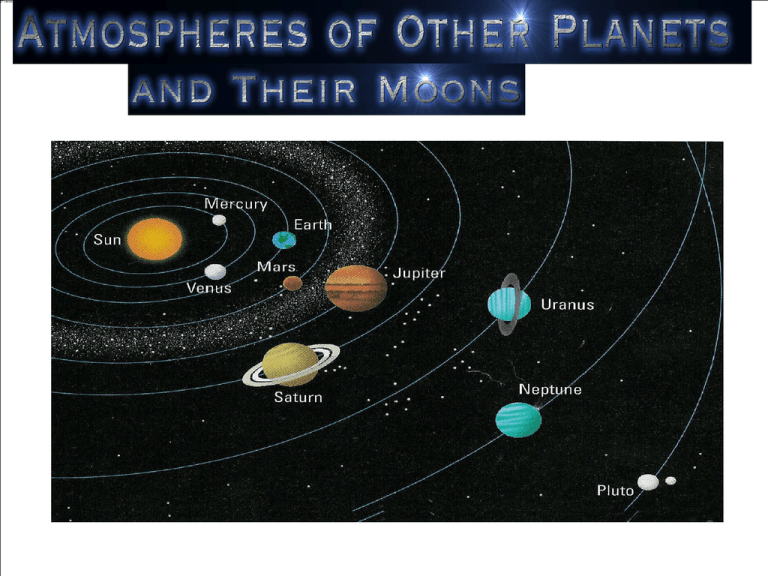
Uranus •The temperature in the atmosphere of Uranus that was facing the sun was nearly the same as the side that was not •Uranus's atmosphere is made up of hydrogen, helium and methane. The methane forms into a layer of cloud because the temperature is so cold in the upper atmosphere (it is about two hundred and twenty five degrees Celsius). • The greenish color of Uranus is due to the atmosphere being made up of large amounts of methane gas. Moons of Uranus • Uranus has 5 moons: Titania, Oberon, Umbriel, Ariel, and Miranda • Titania has big valleys • Oberon has craters that are over flooded with dark material • Umbriel has a very dark surface • Miranda is the most interesting. Miranda has grooves that are V-shaped and has ridges in its surface Mercury • The atmosphere is not stable. Atoms are continuously lost and replenished. Mercury has a very thin atmosphere; it is barely there. • Water vapor is probably also present. • Particles in the atmosphere move very fast, allowing gases to escape into space • Water is being brought to Mercury by comets in space. • • • • • • • • • Mercury’s Content Potassium Sodium Oxygen Argon Helium Nitrogen Carbon dioxide Water Hydrogen 31.7% 24.9% 9.5% 7.0% 5.9% 5.2% 3.6% 3.4% 3.2% Pluto • Pluto has a thin atmosphere • Pluto’s density suggests that it has a rocky core. Above this rocky core is a layer of ice. • Pluto contains Methane, Carbon Monixide and Nitrogen. • Pluto has solid nitrogen and carbon monoxide ices on the surface • As Pluto moves away from the sun, more of its atmosphere freezes and falls to the ground. Pluto’s Moon • Pluto’s moon is named Charon. • It was discovered in 1978. • Its diameter is about half the size of Pluto’s. • Due to the unusual similarity in size between Charon and Pluto, they are sometimes considered a double planet. • Charon has no atmosphere. • Charon and Pluto are to be visited by the New Horizons mission in July 2015. Saturn’s Atmosphere • The surface of Saturn has colored bands, just like Jupiter. These areas on Saturn are rising and sinking gases • Has a source of heat • Saturn's upper atmosphere is less dense and its core is a lot more dense than water. • Saturn is made mainly of sulfur. Sulfur makes Saturn look yellow. •Has 18 moons including the most interesting, Titan •Second largest moon in the solar system •Density= 2g/cm3 •Titan is the only moon in our solar system to have a dense atmosphere •Titan is the only known moon with a fully developed atmosphere •The atmosphere is 98.4% nitrogen with the left over 1.6% containing of methane and a little bit of gases such as hydrocarbons, propane, argon, carbon dioxide, carbon monoxide, and helium. Jupiter’s Atmosphere • Has light and dark colored bands • The light bands are areas of rising gases • Dark bands are areas of sinking gases • High velocity winds are between the bands • Jupiter's atmosphere is composed of 90% Hydrogen and 10% Helium and traces of methane, water vapor and rock. There are also traces of carbon, neon, oxygen, and sulphur. The outermost layer of the atmosphere contains crystals of frozen ammonia Jupiter's Moons • Jupiter has 16 moons. The 4 largest moons are Castillo, Europa, Io, Ganymede. • Io has a yellow-orange-reddish color. Io has 10 active volcanoes. When the volcanoes erupts, the materials go on the surface. This a cause for the color on its surface. • Europa’s core is made of rock. It has a smooth and shiny surface. It is thought that Europa has oceans under the layers of ice. • Ganymede and Castillo have a rock and ice interior. On the surface, there appears to be a thick layer of rocks. Venus • Venus has pale yellow clouds in its atmosphere. The clouds cover the planet completely • Venus consists of carbon dioxide, which acts as a roof, letting not that much heat escape. • The temperature in its atmosphere is 482 degrees Celsius • Has no moon • Venus’s atmosphere is 90 times more massive than ours • There are 200 mph winds at the cloud tops. The clouds are made up of sulfur dioxide and sulfuric acid droplets. Neptune • Neptune has deep layers of low density materials • Neptune is made up of Hydrogen, Helium and Methane (similar to Uranus) • Has faint dark colored bands • The blue appearance is due to the methane in its atmosphere Neptune's Moon • Neptune has eight moons, Triton being the largest • Triton has a diameter of 2,700 kilometers (1,680 miles). It was discovered by William Lassell, an astronomer, on October 10. Triton is colder than any other measured object in the Solar System with a surface temperature of 235° C. • It has an extremely thin atmosphere • The southern atmosphere of Triton has ice caps • 95% carbon dioxide and 5% nitrogen & argon with some other gases • The atmospheric pressure is 150 times lower than earth due to the atmosphere being thin • Mars has polar caps- they are frozen with carbon dioxide and water • Mars’s northern atmosphere is a smooth lowland volcanic material including some craters • Has the largest volcano in the solar systemOlympus Mons. It is a shield volcano measuring 600 kilometers across and 25 kilometers high • Mars does not have a moon Interactive Sites • http://janus.astro.umd.edu/javadir/orbits/ss v.html • http://www.cfa.harvard.edu/afoe/simulation /e3.html • http://www.nasa.gov/mov/116648main_Col lidingWdwarves.mov Bibliography • "Black Hole." Wikipedia. 23 May 2006. 23 May 2006 <http://en.wikipedia.org/wiki/Black_Holes#Form ation>. • "Saturn." Wikipedia. 24 May 2006 <http://en.wikipedia.org/wiki/Saturn>. • Seeds. Foundations of Astronomy. Belmont: Wadsworth Publishing Company,1986. 423-450. • Spaulding, Namowitz, and Nancy E. Earth Science. Dallas: McDougal Littell, 1999. 385-423.




